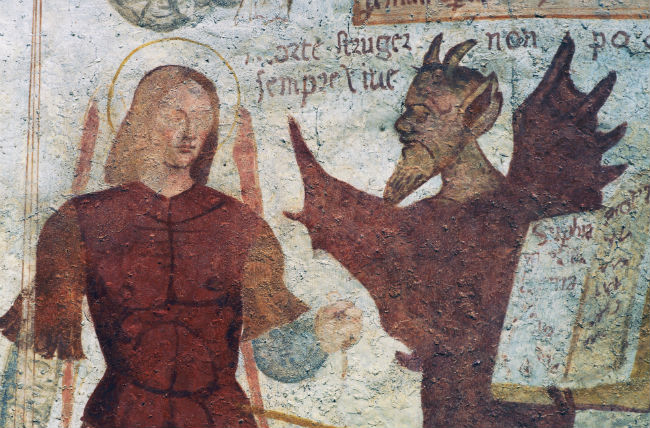
In Sam Raimi’s 1981 horror film, The Evil Dead (Ash vs. Evil Dead premieres on Starz this Halloween, and you can read our interview with Raimi here), the protagonists accidentally summon a swarm of demons when they play a tape recording of someone reading out of The Book of the Dead, also known as the Necronomicon Ex-Mortis. Bound in flesh and written in human blood, the fictional book describes rituals to summon or detain evil spirits. It’s not the first time a book of that nature appeared in pop-culture. H.P. Lovecraft frequently inserted the Necronomicon into his works of fiction in the early half of the 1900s. What Raimi and Lovecraft were calling upon for inspiration in their stories is what’s generally referred to as a grimoire — a book embedded in the realm of occult literature. Rebecca Romney, Bauman Rare Books manager and frequent guest on Pawn Stars, spoke with Uproxx about the definition of a grimoire:
A grimoire, at risk of being too simplistic, is a text that teaches practical magic. As such, it is usually highly religious in nature, under the premise that the power to achieve supernatural results comes from supernatural sources (e.g. divinity or demons). The grimoire tradition is European, at least in the form to which we are referring when we use the term “grimoire”; however, its roots go back to ancient civilizations.
James Frazer’s landmark 1890 study on religion and magic, The Golden Bough, broaches the concept of the necessity for early civilizations to engage in magical processes relating to fertility and fruitful harvests, among other essentials. Frazer describes practical magic “as a system of natural law, that is, as a statement of the rules which determine the sequence of events throughout the world.”
Based on Frazer’s work, one could say that the need for magic derived from the hunger for natural human requisites — food, love, success. Grimoires promise that with the proper application, one can attain their goals through magic devices, animal sacrifices and even the summoning of the supernatural. Many of these texts contain spells, alchemic formulas, and some even contain instructions for exorcisms. One specific text allegedly claims that it can summon Satan himself. (More on that later.) But do any of these books really contain an inherent power, or even proper instructions, to tap into divine or demonic sources? Rebecca Romney has a simple answer for that question.
“No,” she told us.
William Dailey, of William Dailey Rare Books, an expert who’s specialized in occult literature for 45 years, doesn’t wholeheartedly agree. He told Uproxx:
I’m fairly practical when it comes to things like this. But I think occasionally, there can be potent powers. Just like I’ve been in a few houses that I felt were haunted. I don’t necessarily believe in ghosts, but I’ve felt it and seen it a few times. So, I think that there are spirits that inhabit locations, or in this case, might have inhabited a book. The theory that I like is that these are people, entities, that don’t know that they’re dead, and they’re hanging around our world and they don’t want to move on into what lies beyond.
Lou Donato of Amber Unicorn Books, specializing in occult and metaphysics, also has 45 years of experience in the business. He told Uproxx that he believes, without a shadow of a doubt, certain books can be portals into the paranormal realm:
Yes, I believe in serious supernatural because we’re just functioning in a three-dimensional world, and there are more dimensions out there than our senses are aware of. And if someone has a good receiver and transmitter they might be able to tap into it. That’s where you get into Rhine University (a parapsychology research institute) with the psych material. You can’t discount it. There’s been too many unexplained phenomenas that science just scratches their head.
Between the Lines
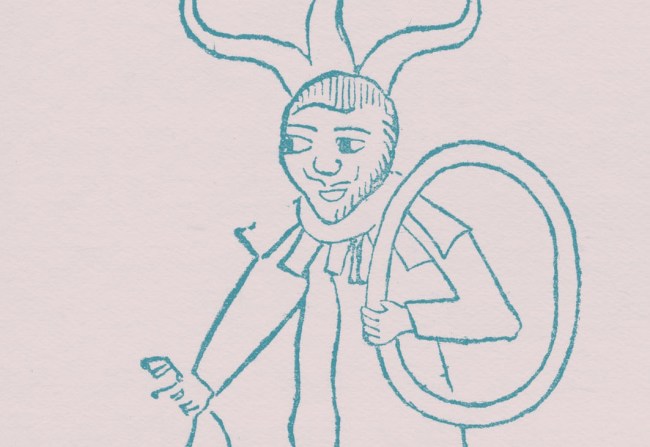
Figure from The Grand Grimoire
According to Dailey, “[Grimoires] have a long history — probably go back to preprinted versions, before Johannes Gutenberg’s [printing press, circa. 1436]. They really flourished, at least the ones that are available, in the 18th century.”
Donato dates the emergence of grimoires back even further. “We’re going back actually into the pre-Babylonian era, where there’s probably no records,” he said. “Your shamans or priests or witch doctors — anything that dealt with the supernatural. It really didn’t take on a name until much later in time. A lot of it was in foreign tongues, of course.”
There’s much conjecture associated with many of the grimoire texts, especially those that date back centuries. Authors, places of origin,and even the actual existence of certain books have been thrown into question by a variety of voices populating the occult sphere. One of these texts is the infamous Red Dragon, also know as The Grand Grimoire or The Gospel of Satan. Dailey claims that the original text was written in 1521; it was apparently rediscovered in Jerusalem in 1750 in the tomb of King Solomon. (In fact, many grimoires are attributed to Solomon.) There are more recent copies that exist, ones that have a lineage tracing back to Antonio Venitiana del Rabina, who, in the 18th century, supposedly translated the original writings of King Solomon into the copies that are readily available on Amazon. Of the legends surrounding the text: It is allegedly indestructible, based on a 13th century grimoire by Honorius of Thebes (who may or may not have been Pope Honorius III), has instructions on summoning demons — including Satan himself — and the original copy is located in the Vatican archives.
“Any of these attributions to Popes are erroneous,” Dailey said. “It would have been done by authors or practitioners. It was very common to attribute texts to famous people in order to make them sound impressive.”
As for the lore that the original Red Dragon is impervious to damage and that it can summon Satan, Dailey said, “I’ve heard both of those stories, and I would imagine they’re mythical. They make good stories.”
Those bizarre myths may be easy to deem false, but when conversation turns to the idea that the original iteration is kept in the Vatican, Dailey doesn’t have such a solid answer.
“As of yet, we don’t know everything that’s in their vaults,” he said. “They supposedly have great collections of not just magic and black magic, they collected erotica supposedly, and all the forbidden books. I don’t know anyone that’s had access to [all of] that. It’s highly guarded.”
Whether or not the legends surrounding the Red Dragon are actually true, there’s no denying that it contains some unsettling ideas; take, for instance, this hierarchy of demons outlined within its pages:
For many grimoires, the current editions that you can find in stores or online, do not directly reflect the original manuscripts from which they were wrought; it’s an unfortunate by-product of centuries of dilution, transcriptions and translations.
“You have a lot of authors that the publishing house is saying ‘Write something. You’ve already written some good books and they’ve sold. Give us something on grimoires,'” Donato said. “And they’ll make stuff up as they go. It’s not factual. They’ve taken other people’s works, and they’ve revamped it. And if they leave stuff out that’s pertinent to the original piece they worked on, they don’t care. There’s a lot of words that get mistranslated. The vocabulary used a couple hundred years ago is different than ours, and it can be misconstrued intentionally or by accident.”
Still, the closer you get to an original iteration of a grimoire or instructional occult text, the closer you may be to benevolent or malevolent forces. The existence of the supernatural is not an idea that all experts and analysts subscribe to, but it is a plausible notion for those who make mysticism part of their agenda.
Mystic Men
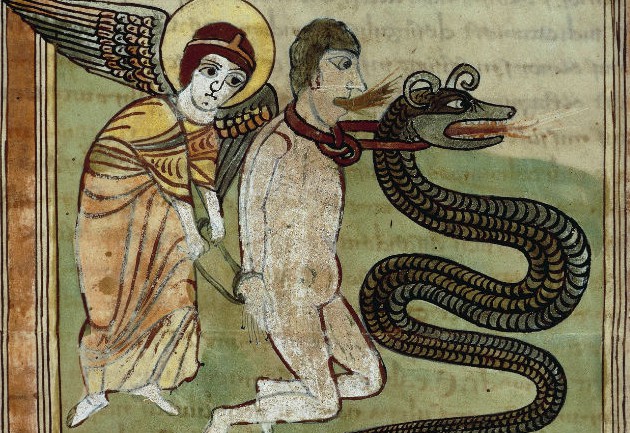
It’s hard to get your hands on an original copy of any kind of fabled grimoire, whether it’s in the Vatican or not. “Most of the celebrated grimoires are unique manuscripts in institutions that aren’t going to appear on the market any time soon,” Romney said. “One of the great occult books that should be included in the best of collections is the Malleus Maleficarum, first printed in 1487. It’s quite a rare book, and expensive (usually tens of thousands of dollars), but a cornerstone for the occult.”
The Malleus Maleficarum, which translates from Latin into The Hammer of Witches, is less of a grimoire and more of a “medieval treatise on witches.” Authored by Heinrich Kramer and Jacob Sprenger — inquisitors for the Catholic Church — the book details the process of identifying and convicting witches. (Witchcraft is still a prominent issue in some nations: The Daily Mail claims that 50,000 children in the Democratic Republic of Congo have been accused of the magical art, and left to fend for themselves on the streets due to the implied connotations of such judgement.)
There are other prominent works of text in the occult/grimoire field. The Key of Solomon — which spawned The Lesser Key of Solomon in the 17th century — has copies dating back to the 14th or 15th century, and it contains exorcism rituals, instructions for summoning demonic entities, illustrations of pentacles, as well as invocations and conjurations concerning love and invisibility, to name a few. Today, copies of the work can be found under the name of Samuel Liddell MacGregor Mathers, a 19th century British occultist who translated an 18th century French Colorno manuscript. Mathers lived an interesting life; a Freemason in his early 20s, Mathers would later quit the organization and help create the Hermetic Order of the Golden Dawn in 1887, along with Dr. Wynn Westcott and Dr. William Woodman. The Golden Dawn, still active today, is a group concerned with the edification of magic and metaphysics. According to their website, their “vision” reads: “To make Magicians – in order to restore, equilibrate, and decontaminate this world …To establish heaven on earth now and in the future.”
Your average citizen does not have the ability to just pick up a grimoire and begin conjuring angels and demons. To be a magician, one must go through a series of tests, cleansing rituals, and — as in anything else — practice makes perfect.
“I don’t think it’s necessarily the grimoires that have the power, but the practitioner, a magician who has the talent and skills may very well be able to do these things,” says Dailey. “The grimoires are just a guide and a magician would probably have read many and practiced the many different things and put them all together for his own techniques. Much like Alistair Crowley did, he created his own form of magic after reading a great deal of occult books.”
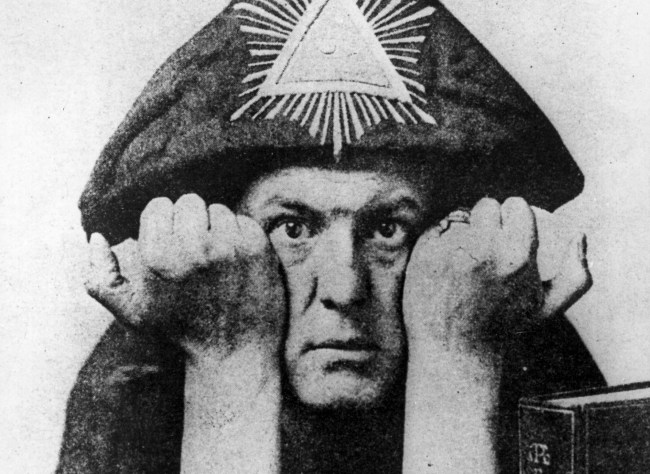
Aleister Crowley
Another notable member of The Golden Dawn, Aleister Crowley (1875-1947) was an occultist, author, mystic and magician who would later go on to create Thelema, a religion he established with The Book of the Law (1904). Crowley claimed that an entity known as Aiwass dictated the contents of the book to him over the span of three days. These figures raise interesting wrinkles in the notion that grimoires and other texts in the occult are solely involved in the propagation of dark arts, or black magic. As Romney explains, that is not the case:
A common misconception of a grimoire is that it’s inherently associated with the Devil, demons, or just, shall we say, the Dark Side of the Force. In fact many believed they were working on the side of good—using the powers of angels, for example. There are often elaborate purification rituals one must go through before practicing anything in a grimoire in order to cleanse oneself of sin to be worthy of using that divine power. We see grimoires as black magic exclusively. John Dee would disagree.
Dr. John Dee (1527-1608/9) was a British occultist, alchemist and scientist who did not conjure demons, but angels. Some of the tales attributed to him include placing a hex on the Spanish Armada and astrologically predicting future events for Queen Elizabeth I. Dr. Dee is responsible for the creation of the highly esoteric Monas Hieroglyphica, a treatise of rules and symbols that he claimed were the guidelines for knowledge of a higher plane. With Edward Kelly, Dee continued to research acts of divination until his death in the early 1600s.
Lou Donato believes that symbols can play a powerful role in the development of magic, sharing this anecdote:
One occurrence, when I was in Tucson. There was some kids going to university — I was teaching out there for a while — and they’d go down into Mexico and bring back marijuana in one of the old VW vans. They painted a bunch of invisibility signs on the packages. Within a month they had been hit [detained] three times, but they [authorities] never saw the packages.
Although Dee and others like him sought after sanctified channels of the supernatural, not all occultists — nor all texts — followed that path.
Path of Shadows
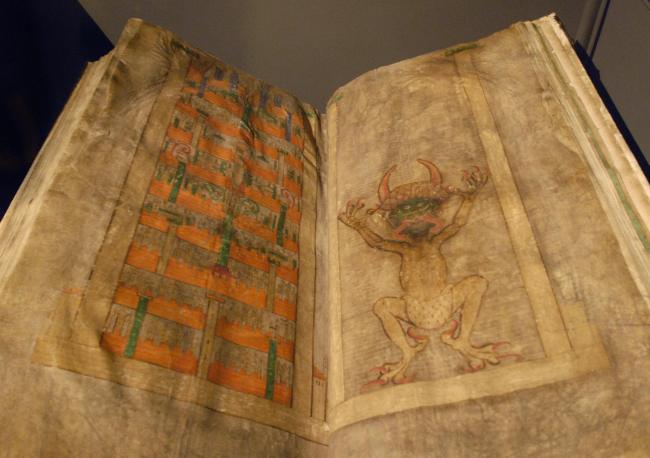
One enormous tome that has gained a reputation since its creation is the Codex Gigas, also known as “The Devil’s Bible.” As the legend goes, the Codex — all 165 lbs. of it — was the work of one solitary, 13th century monk. This is an actual fact, proven by analysis that shows a consistent penmanship and ink throughout the massive work which took at least 160 animal skins to create. Known as the largest medieval manuscript in the world (it was at one time the eighth wonder of the world), National Geographic conducted a study that revealed that not only was it created by just one man, it would have taken 25 to 30 years of steady work to produce all of the text and illustrations.
An incredulous aura surrounds the manuscript, much of it owed to the mythical tale of its construction. According to legend, a Benedictine monk, in what is now known as the Czech Republic, had broken his vows, and as punishment, he was sentenced to be walled up alive. His only means of nullifying his fate was a promise to create a book so monumental in scope, that it would immortalize the monastery. The monk was given only 24 hours to complete the project, and in the final hour, he recognized that he could not finish in time. Instead of praying to the Gods, the monk chose to summon the Devil, who finished the tome for him. Depending on who’s telling the story, it was the monk — in paying respect to his co-writer — that created a depiction of the Devil (see above photo), or it was Satan himself, signaling his involvement by creating a portrait of himself.
Satan, in fact, has a long lineage in literature, obviously dating back to The Bible, and is still prevalent in the contemporary work of Satanists and those interested in the dark side of the occult. Lou Donato had one such run-in with a highly-regarded member of the Satanic community. “[I had] a little bit of an uncomfortable feeling, back in the 70s,” he said. “Anton LaVey came in and he was promoting one of his current publications, and, uh, just a person that I wouldn’t buy a used car from. I didn’t trust him.”
Anton LaVey was known as “The Black Pope,” and is widely considered the father of modern Satanism. In 1966, LaVey created the Church of Satan in San Francisco, and in 1969, he published The Satanic Bible, a book that remains a keystone for present-day Satanists. Besides cementing the religion’s guidelines, LaVey challenged the Ten Commandments, encouraged hedonism and included various magic rituals inside his Bible.
Rebecca Romney may not believe in supernatural literature, but there are limitations on the kinds of texts she’ll approach. “There are certain books that rare book dealers won’t handle on principle,” she said, “but that’s less likely grimoire and more of the Nazi Germany ilk.”
One text tainted by the hands of Nazi Germany is the Oera Linda. The book, written in Old Frisian — a centuries-old West Germanic language — was first discovered in the 1860s, but was soon after recognized as a hoax for its depictions and mentions of Atlantis and other events in ancient civilizations going back to 2194 BC. Nevertheless, in the 1930s, Heinrich Himmler — an occultist and one of the Nazi Party’s leading officers — took kind to the work, and infused it into his Nazi philosophy. (Bigotry themes pervade portions of the work, especially against people of color.) The book would also be known as “Himmler’s Bible,” and it became a favorite of Nazi occultists.
The Oera Linda brings up an interesting thought: Perhaps it’s not the demons or evil spirits attached to certain texts, but the intentions of man in invoking the ideas presented that provides a true danger. When asked if she’s ever been disturbed by a piece of literature, Romney did not recall anything of a supernatural sort. Rather, she pointed to the evils of mankind. “Texts bound in human skin,” she said. “Sometimes this was done by the direction and consent of the “source” of the leather, but oftentimes it was not. Monsters are scary, but humans who do such things are the real horrors.”
Dailey, while seemingly on the fence about his convictions in the manifested, supernatural realm, certainly believes that a hidden power lies in some texts:
I have a memory of 30 to 35 years ago, going into Acres of Books, which is a famous book shop in Long Beach. I went to the occult section and back in those days you could find some treasures for very little money. I pulled a two-volume set off the shelf, it was related to occult, and I got the creepiest vibes I’ve ever had from a book. And I’m not one to necessarily believe in all these things. But this book definitely had bad vibes. I wish I remembered the author and title of it. But I promptly put it back on the shelf and moved on. It was very strange.
The End Is Near
There will always be atheists and agnostics who are dubious of the demonic or divine connotations associated with literature or magic or religion. That’s fine, of course, they have every right. But, in this life we encounter certain moments of desperation — and in those harrowing times even the skeptics are temped to try a foxhole prayer. The bricks are stacking before their eyes, walling them in and the clock has run out.
It’s worth asking, if you were in that situation, what would you do? Would you run your fingers along the cracks and chip away at the grout, hoping a ray of sunlight pierces through? Would you clasp your hands and point your chin towards the sky? Or, like the fabled author of Codex Gigas, would you set your sights much lower?






